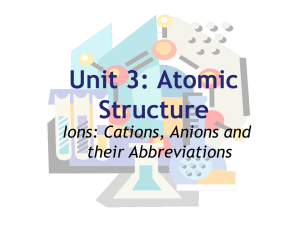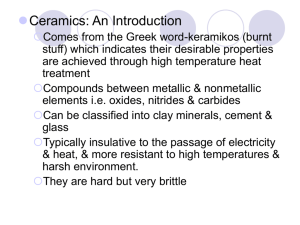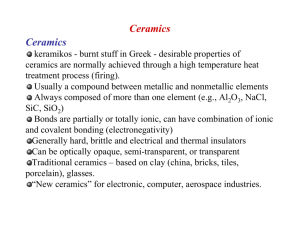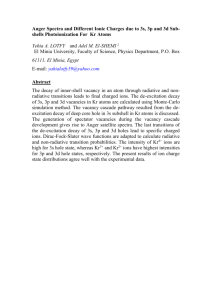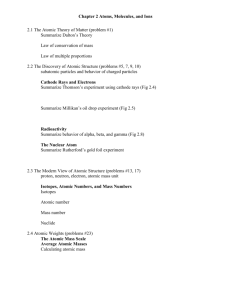Ceramics
advertisement
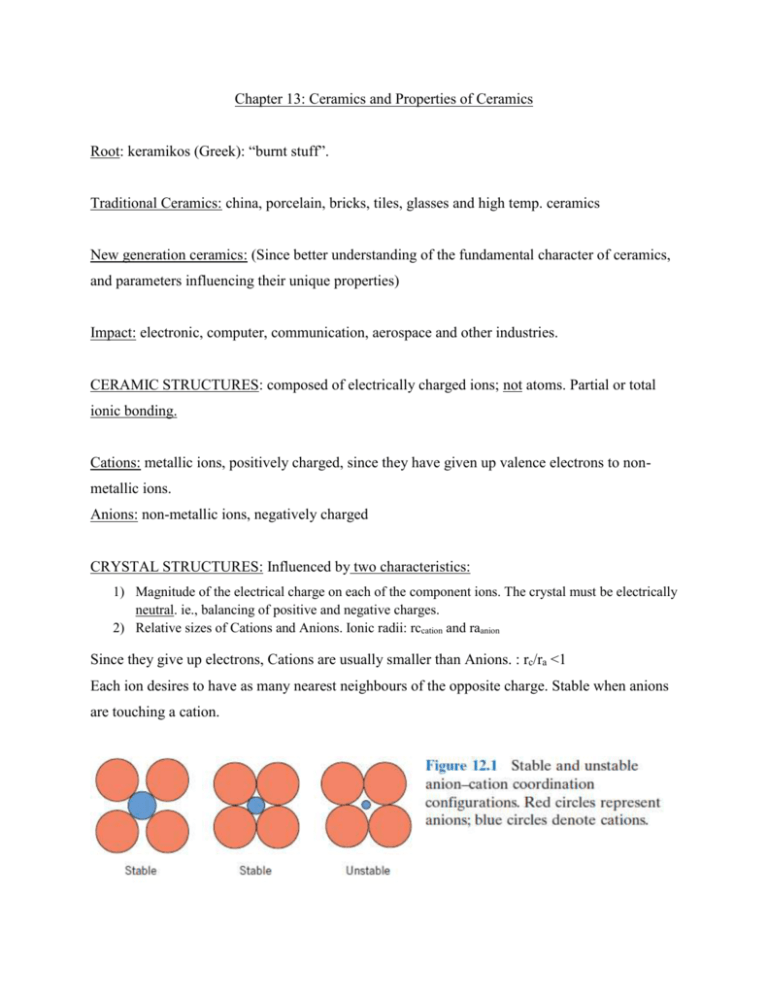
Chapter 13: Ceramics and Properties of Ceramics Root: keramikos (Greek): “burnt stuff”. Traditional Ceramics: china, porcelain, bricks, tiles, glasses and high temp. ceramics New generation ceramics: (Since better understanding of the fundamental character of ceramics, and parameters influencing their unique properties) Impact: electronic, computer, communication, aerospace and other industries. CERAMIC STRUCTURES: composed of electrically charged ions; not atoms. Partial or total ionic bonding. Cations: metallic ions, positively charged, since they have given up valence electrons to nonmetallic ions. Anions: non-metallic ions, negatively charged CRYSTAL STRUCTURES: Influenced by two characteristics: 1) Magnitude of the electrical charge on each of the component ions. The crystal must be electrically neutral. ie., balancing of positive and negative charges. 2) Relative sizes of Cations and Anions. Ionic radii: rccation and raanion Since they give up electrons, Cations are usually smaller than Anions. : rc/ra <1 Each ion desires to have as many nearest neighbours of the opposite charge. Stable when anions are touching a cation. Coordination No: number of anion nearest neighbours of a cation. P. 378-379 Table 13.1: Table 13.2 Ionic radii listed Problem 13.1 Show that the minimum cation to anion radius ratio for the coordination number 3 is 0.155. AP=rA AO= rA + rC cos (30o)=AP/AO= = Types of Structures AX-Type Crystal Structure Equal number of cations and anions Several different crystal structures for AX compounds 1) AX-Rock Salt Structure: NaCl/Rock salt Coordination number for anions and cations: 6 cation/anion ratio: 0.414-0.732 FCC arrangement of anions Two interpenetrating FCC lattices FCC arrangement of cations Eg. NaCl, MgO, MnS, LiF and FeO 2) AX - Cesium Chloride Structure: CsCl Coordination number for both ions: 8 Anions at centres of cube Cation at body (cube-centre) 3) AX – Zinc Blende Structure: ZnS/sphalerite/Zinc Blende Coordination number: 4 S atoms: at cube corners and face positions Zn atoms: interior tetrahedral positions, Each Zn atom is bonded to four S atoms and vice versa. Often highly covalent. eg. ZnS, ZnTe, SiC 4) AmXp Type Crystal Structures m and/or p ≠ 1 eg. AX2: CaF2/Flourite Coordination Number: 8 rc/ra = 0.8 Similar to CsCl structure. But, only half as many Ca2+ as F+ ions so, only half the centres cube positions are occupied by Ca2+ ions. Eg., UO2, PuO2 and ThO2 5) AmBnXp Type Crystal Structure ("Two types of cations”) eg., BaTiO3/Barium Titanate Ceramic Density Calculations p.36 Where: n=number of atoms associated with each unit cell A= atomic weight Vc = Volume of the unit cell Na = Avagadro’s number (6.023 x 10^23 atoms /mole) Where: n' = the number of formula units within the unit cell (eg.BaTiO3: 1, 2 ,3) AC = the sum of the atomic weights of all cations in the formula unit AA = the sum of the atomic weights of all the anions in the formula unit VC = the unit cell volume NA = Avagadro’s number Compute the theoretical density of NaCl on the basis of crystal structure. How does this compare with its measured density? n' = 4/unit cell AC = ANa = 22.99 g/mol AA = Acl = 35.45 g/mol Vc = a3 a = 2(rNa + rcl) rNa= 0.102 nm rcl =0.181nm =2.14 g/cm3 (Expected value: 2.16 g/cm3) Ceramic Phase Diagrams The Al2O3-Cr2O3 System Isomorphous (density similar to Cu-Ni) Fig. 13.24: Al2O3-Cr2O3 Substitution Solid Solution. (Al3+ substitutes for Cr3+), same charge. Similar radii: 0.053nm (Al3+) 0.063 nm (Cr3+) Same crystal structure The MgO-Al2O3 System (similar to Pb-Mg) Intermediate phase: MgAl2O4 spinel (ie., MgO-Al2O3) Fig.13.25: Distinct compound, single phase field (not a line as for Mg2Pb) Spinel nonstoichiometric (range of compositions) Differences in charge: Mg2+ Al3+ 0.072 nm (Mg2+) 0.053 nm (Al3+) MgO is virtually insoluble in Al2O3; so no terminal solid solution at RHS Two eutectics Constant melting of spinel at 2100°C The ZrO2-CaO System (zirconia/calcium) Three reactions: eutectic, pertectic and eutectoid. Three different crystal structures: tetragonal, monoclinic, cubic Pure ZrO2: tetragonal to monoclinic at 1000°C a= b ≠ c a≠b≠c α = β = γ = 90° α = γ = 90° ≠ β Results in cracking so, “stabilize” by adding 3 to 7 wt.% CaO to ZrO2. This eliminates cracking, as no such phase change occurs. p.402 The SiO2-Al2O3 System SiO2 and AL2O3: Not mutually soluble No terminal solid solutions at both extremities Si02: cristobalite (most stable form) 3Al2O3-2SiO2: Mullite Simple eutectic at 1587 oC p.407 Plastic Deformation: Crystalline Ceramics: Why are crystalline ceramics hard and brittle? Few slip systems for the movement of dislocations (due to the electrically charged nature of ions). Electrostatic repulsion of like charges eliminates several possibilities of slip (disloc. motion) Deformation by motion of dislocations Hard and brittle :difficulty in dislocation motion (slip) Bonding: ionic; therefore few slip systems (planes and directions) for dislocation motion, due to electrically charged nature of ion. For slip in some direction, ions are brought close to one and other; but this type of motion is restricted due to electrostatic repulsion For ceramics with covalent bonding, slip is difficult because: 1. Covalent bonds are strong 2. Limited no. of slip systems 3. Dislocation structures are complex p.407 Noncrystalline Ceramics (glassy) Deformation is not by dislocation motion But by viscous flow Rate of deformation applied stress Atoms/ions slide past one another by breaking/reforming bonds Viscosity: measure of resistance to deformation Where: η, viscosity. Poises (P) pascal-second τ, Applied shear stress dv, change in viscosity dy, distance in direction perpendicular to and away from plates. 1Poise 1 P=1 dyne-second/cm2 1Pa-s=1N-sec/m2 10 P=1 Pa-s Water: 10-3 Pa-s Glass: very large (since strong interatomic bonding). As temperature increases, the magnitude of bonding is diminished, sliding motion or flow of atoms or ions is facilitated, then there is a decrease in viscosity.
